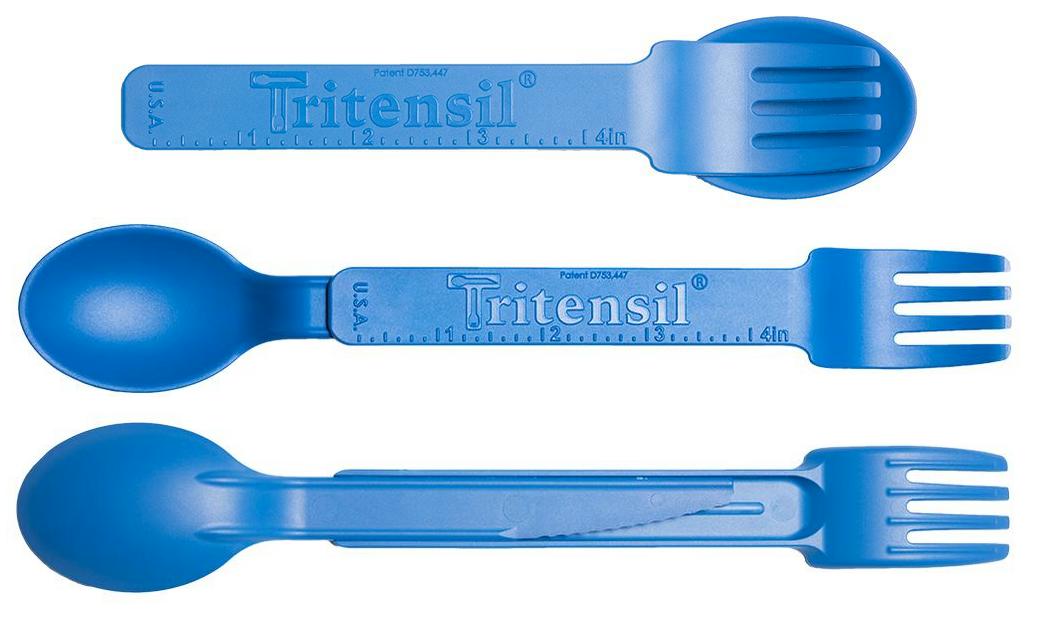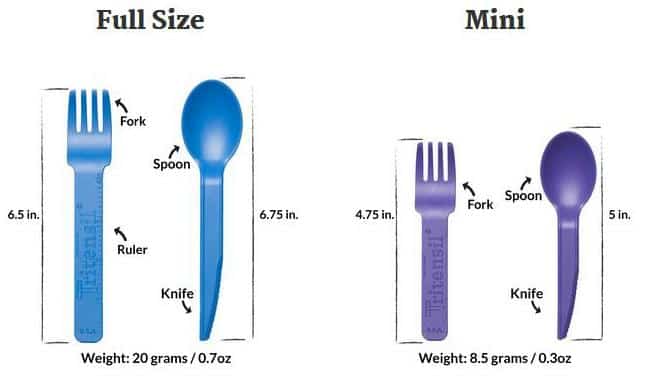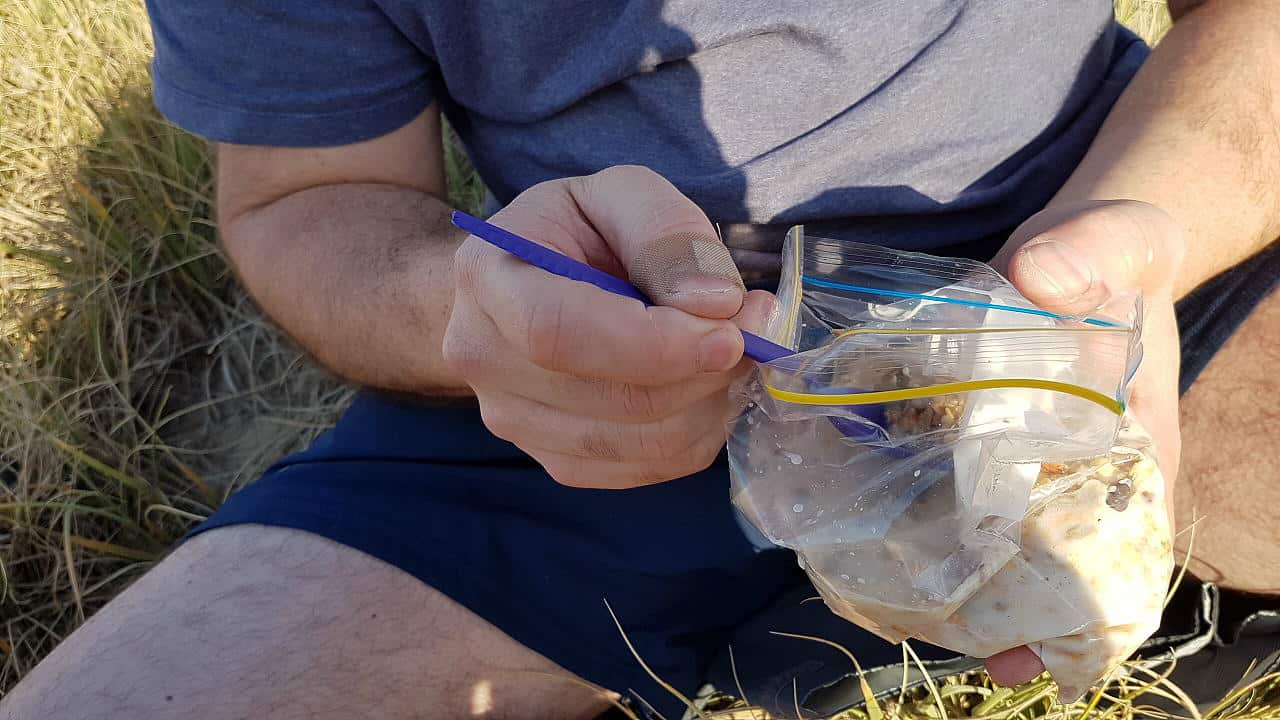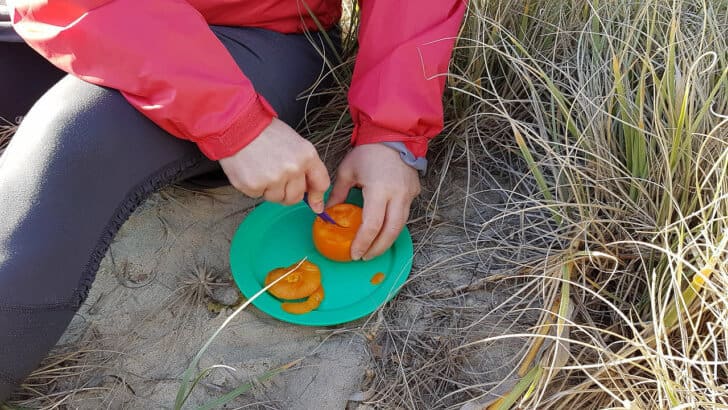The concept of the Tritensil® came about from over twenty five years of first hand wildland firefighting and military experience. The weight and volume limitations of these two communities extends to almost every other outdoor adventure. When you have to carry all of your gear, there is an old saying that ounces equal pounds and pounds equal pain. By combining a scalloped knife into the spoon handle, the Tritensil provides the full capabilities of a fork, spoon and knife in a two piece set. Whether the main course is soup or steak and yes, this knife will cut steak, the Tritensil will have you covered.
The Patented interlocking handle design provides a nesting configuration for compact storage without the need of special clips, bands or cases. Not only are the fork tines and knife protected from damage while nesting but the storage configuration keeps the two Tritensil pieces snuggly secured to each other minimizing the chance of loss and unwanted noise. The interlocking design also allows the Tritensil to be configured into an extended Spork almost doubling the overall useable length for those times you may find yourself eating out of a pouch. Learn more at https://www.tritensil.com/

Features and Specifications
The Tritensil is made from a proprietary BPA, BPS and BPF Free, RoHS Compliant, FDA Food Grade Polymer making it lightweight.
Standard:
- 20 g (0.7oz)
- MSRP: USD $9
Mini:
- 8.5 g (0.3oz)
- MSRP: USD $7
Colours red, blue, orange, pink, purple and ‘tactical green’ which is almost grey.
Someone mentioned these in a BPL Forum thread and they looked interesting, so I contacted the company to see if they were interested in a product review. They were, so I suggested they send me a couple of sets. They sent me a box full!
What to do? Clearly, the best path would be to farm most of the sets out to other known BPL members, to get their comments as well, so I did. The call went out to Australian members as the cost of postage back to the USA would have been too high. So we will start with my comments, then go on to comments from others.

Commentary by Roger Caffin
It’s a knife/fork/spoon set done in hard plastic. There is a fork with a medium-length handle, and a spoon with a knife for a handle. The set comes neatly packaged together. You need to read the instructions to be able to separate the two bits – they come apart with a definite click. The interesting thing is that you can reassemble the two bits to make a long spoon or fork: good for getting to the bottom of deep pots and bags.
In fact there are two versions: a standard size and a mini size. Most of our comments are about the standard size bits as most of us thought the mini size was too small. It will be clear when the comments apply to the mini size.
The spoon size and shape are OK. The bowl has a good shape and size for holding stew and soup, and does not have spork slots (tines) which make the bowl less practical for anything liquid. The knife handle on the spoon is a bit strange. As mentioned, you can clip the fork onto it to make long handle. That does mean you have either a spoon or a fork – and possibly a slightly messy hand when the other end dribbles downwards. Well, yes, a bit um: lick fork clean first. Without the fork extension the spoon handle is a bit short, but still usable.
The fork was more difficult to test as I don’t normally carry one. Perhaps think of it as a freebie part of the extended spoon handle. That said, the tines are very strong and wedge-ended for penetration. Not sure any of our bushwalking food would need that. I tested the tines at home on the hard biscuit crust of a quiche my wife made: they went through the crust with no problems.
One reason the tines are so strong is that they are bigger/fatter than metal tines. I found that trying to pick up a lump of cooked potato or pumpkin tended to split the lump rather than pick it up. Oh well – back to the spoon.
I have little faith in knives made of anything other than steel: in general they don’t work. However, while this knife looks blunt, the serrated edge was strong and did cut quite a few things like wholemeal bread, hard cheese and dry sausage (aka salami). It did better than I expected.
However, the asymmetric nature of the edge means the blade tends to shear off sideways at an angle. I found I could compensate for this after a while by seriously angling the blade from the start. That just feels a bit strange. Also, the blade is a bit narrow in my opinion, so that spreading butter and jam is more difficult than with a wider blade. Ah yes – clean the spoon end thoroughly before trying to use the knife end.
Commentary by Franco Darioli

Having spotted the Tritensils a couple of years ago , I was surprised that there could be a new twist to the Spork/Foon type of eating utensils. That is because over the years I have tried many different versions (I still have some), eventually opting for the long Ti spoon and the Opinel knife (about 50 g combined, feel free to faint now) because they work for me. Most of all I prefer the feel of the wooden spoons but they are not long enough to reach the bottom of my Caldera Cone caddy or the 700ml pot without rubbing against the side. The same applies to the other spork/foon combos. This one, the Tritensil looked promising.
When assembled and used as a spoon it is as long as the BPL Ti version. The fork bit does not interfere with the handling. The knife works for hard cheese and slicing salami but not as well, for me, as my Opinel. However, unlike with my knife, the Tritensil bits leave no taste that I can detect. I deliberately tried tomato based meals as well as curry. The feel in the mouth is good too, better than Ti, at least until Ti warms up.
It is the best version of this type of eating utensils I have tried so far, but I am used to the long spoon/Opinel combo (my only knife) and I have an my emotional attachment to the Opinel (I had one as a kid).
Commentary by Gordon Bedford

What can one say about a knife, fork and spoon set? I have used a spoon and a lightweight folding steel knife as standard equipment for years. The spoon is a white plastic polymer material, Lexan I think. I have never bothered with a fork except when car camping. Then along comes the Tritensil knife fork and spoon set.
I liked the colour orange, easy to distinguish from other objects and not lose in the grass. There are other colours available.
I was skeptical of the design at first. Will I cut myself on the knife when holding the spoon? My hands are dirty. Hold it as a spoon and the knife gets dirty. Hold it as a knife and the spoon gets dirty.
I quickly got the knack of clipping and unclipping the two utensils. How long before wear and tear would prevent that, only long term use would tell.
The spoon functioned like a spoon. I didn’t find anything different about it. Holding the knife end felt strange at first but I soon became accustomed though it never felt smooth and easy to manipulate.
I used it in the bush on walking trips twice for a total of three nights. I only took the knife/spoon. The knife has a serrated edge and functioned surprisingly well. I used it to cut cheese and apple.
At home I found the knife cut bread and even roast lamb. Nevertheless it is not designed to cut a big loaf of bread. It was not great at spreading. How long the serrated edge would stay sharp, time will tell. I suppose it could be sharpened with a small round file.
I tested the fork at home. It has an inch ruler along one edge. It is not really a stabbing fork but worked fine on softer foods. It worked reasonably well with noodles. However the wide rectangular design meant it was not as easy to manipulate as a normal table fork.
The knife is inferior to a steel knife. I would still carry my light weight Deejo knife: it is sharper and can be used for a wider range of tasks. It is also easier to keep clean. I have no intention of carrying a fork.
There is a mini set with teaspoon type dimensions. I didn’t review these. My conclusion is that I will not replace my usual spoon and knife with the Tritensil set. However if you like to include a fork to eat with, then it could be worth a try.
Commentary by Simone Zmood

Overall, we thought the cutlery felt solid and each piece was comfortable to hold. We liked the way the spoon/knife (spife or knoon – what is it called?) and fork clipped together securely and they were easy to separate. Before I provide any more comments, I should give some background on our eating style to provide context for my comments below. When going on multi-night trips we usually have breakfast in a bag at camp or on the track after we have walked for a while, a non-cooked lunch (or all-day scroggin/trail mix), and one-pot meals for dinner so we normally only take a spoon or a spork. Having a piece of cutlery that is long enough to stir the food in the pot without burning fingers is also important to us. Since we did not manage to try this cutlery on an extended trip, I will describe our thoughts on their utility for breakfast and conjecture somewhat for the other eating scenarios.

My husband used the full-sized spoon to eat breakfast out of a zip-lock bag (above). He did notice the serrated edge of the knife whilst he held the spoon but felt it wasn’t a major issue. I used the mini spoon and it wasn’t long enough to easily eat out of a bag without getting food on my fingers but was fine when eating out of a small container. My hands are smaller than hubbie’s so the mini spoon was fine but I also noticed the serrated edge of the knife whilst using it. Since neither of us were cut by the knife, I suspect this is something I would get used to. The shape and depth of the spoon was comfortable to eat from, and the small one still held a decent amount of food.
We often carry fresh food for the first dinner or fresh fruit and veggies for the first few days, so I tested the small knife on a crunchy persimmon (above). My fingers got a bit juicy and I think it would be easier to cut with the bigger knife. Whilst the knife cut well, I still think my little Spyderco Ladybug knife cuts better (and the latter is dual purpose having been used to carve a replacement paddle on an overly exciting packrafting trip). Since the knife is part of the spoon, it would come along on a trip for no extra weight. We didn’t use the fork but it looked solid.
I liked the way the spoon and fork could reverse-clip together to create a spoon with an extended handle. Whilst we didn’t test it, the full-size extended set up would be long enough for our couple cook pot and the short cutlery set would work for my solo kit.
Where To Buy
Disclosure
The manufacturer provided complimentary samples of the products in this review with no obligation required to publish a review. Some links in this review may be affiliate links: if you click on a link and place an order with one of our affiliate merchant partners, Backpacking Light receives a small commission on the sale, at no extra cost to you. These commissions help support our website and create new content – and we’re grateful for your support.



Home › Forums › Tritensil Review